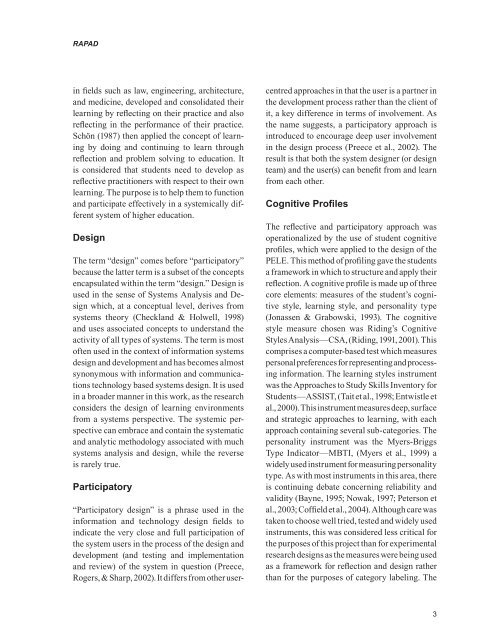Advances in E-learning-Experiences and Methodologies
You also want an ePaper? Increase the reach of your titles
YUMPU automatically turns print PDFs into web optimized ePapers that Google loves.
RAPAD<br />
<strong>in</strong> fields such as law, eng<strong>in</strong>eer<strong>in</strong>g, architecture,<br />
<strong>and</strong> medic<strong>in</strong>e, developed <strong>and</strong> consolidated their<br />
learn<strong>in</strong>g by reflect<strong>in</strong>g on their practice <strong>and</strong> also<br />
reflect<strong>in</strong>g <strong>in</strong> the performance of their practice.<br />
Schön (1987) then applied the concept of learn<strong>in</strong>g<br />
by do<strong>in</strong>g <strong>and</strong> cont<strong>in</strong>u<strong>in</strong>g to learn through<br />
reflection <strong>and</strong> problem solv<strong>in</strong>g to education. It<br />
is considered that students need to develop as<br />
reflective practitioners with respect to their own<br />
learn<strong>in</strong>g. The purpose is to help them to function<br />
<strong>and</strong> participate effectively <strong>in</strong> a systemically different<br />
system of higher education.<br />
design<br />
The term “design” comes before “participatory”<br />
because the latter term is a subset of the concepts<br />
encapsulated with<strong>in</strong> the term “design.” Design is<br />
used <strong>in</strong> the sense of Systems Analysis <strong>and</strong> Design<br />
which, at a conceptual level, derives from<br />
systems theory (Checkl<strong>and</strong> & Holwell, 1998)<br />
<strong>and</strong> uses associated concepts to underst<strong>and</strong> the<br />
activity of all types of systems. The term is most<br />
often used <strong>in</strong> the context of <strong>in</strong>formation systems<br />
design <strong>and</strong> development <strong>and</strong> has becomes almost<br />
synonymous with <strong>in</strong>formation <strong>and</strong> communications<br />
technology based systems design. It is used<br />
<strong>in</strong> a broader manner <strong>in</strong> this work, as the research<br />
considers the design of learn<strong>in</strong>g environments<br />
from a systems perspective. The systemic perspective<br />
can embrace <strong>and</strong> conta<strong>in</strong> the systematic<br />
<strong>and</strong> analytic methodology associated with much<br />
systems analysis <strong>and</strong> design, while the reverse<br />
is rarely true.<br />
Participatory<br />
“Participatory design” is a phrase used <strong>in</strong> the<br />
<strong>in</strong>formation <strong>and</strong> technology design fields to<br />
<strong>in</strong>dicate the very close <strong>and</strong> full participation of<br />
the system users <strong>in</strong> the process of the design <strong>and</strong><br />
development (<strong>and</strong> test<strong>in</strong>g <strong>and</strong> implementation<br />
<strong>and</strong> review) of the system <strong>in</strong> question (Preece,<br />
Rogers, & Sharp, 2002). It differs from other usercentred<br />
approaches <strong>in</strong> that the user is a partner <strong>in</strong><br />
the development process rather than the client of<br />
it, a key difference <strong>in</strong> terms of <strong>in</strong>volvement. As<br />
the name suggests, a participatory approach is<br />
<strong>in</strong>troduced to encourage deep user <strong>in</strong>volvement<br />
<strong>in</strong> the design process (Preece et al., 2002). The<br />
result is that both the system designer (or design<br />
team) <strong>and</strong> the user(s) can benefit from <strong>and</strong> learn<br />
from each other.<br />
Cognitive Profiles<br />
The reflective <strong>and</strong> participatory approach was<br />
operationalized by the use of student cognitive<br />
profiles, which were applied to the design of the<br />
PELE. This method of profil<strong>in</strong>g gave the students<br />
a framework <strong>in</strong> which to structure <strong>and</strong> apply their<br />
reflection. A cognitive profile is made up of three<br />
core elements: measures of the student’s cognitive<br />
style, learn<strong>in</strong>g style, <strong>and</strong> personality type<br />
(Jonassen & Grabowski, 1993). The cognitive<br />
style measure chosen was Rid<strong>in</strong>g’s Cognitive<br />
Styles Analysis—CSA, (Rid<strong>in</strong>g, 1991, 2001). This<br />
comprises a computer-based test which measures<br />
personal preferences for represent<strong>in</strong>g <strong>and</strong> process<strong>in</strong>g<br />
<strong>in</strong>formation. The learn<strong>in</strong>g styles <strong>in</strong>strument<br />
was the Approaches to Study Skills Inventory for<br />
Students—ASSIST, (Tait et al., 1998; Entwistle et<br />
al., 2000). This <strong>in</strong>strument measures deep, surface<br />
<strong>and</strong> strategic approaches to learn<strong>in</strong>g, with each<br />
approach conta<strong>in</strong><strong>in</strong>g several sub-categories. The<br />
personality <strong>in</strong>strument was the Myers-Briggs<br />
Type Indicator—MBTI, (Myers et al., 1999) a<br />
widely used <strong>in</strong>strument for measur<strong>in</strong>g personality<br />
type. As with most <strong>in</strong>struments <strong>in</strong> this area, there<br />
is cont<strong>in</strong>u<strong>in</strong>g debate concern<strong>in</strong>g reliability <strong>and</strong><br />
validity (Bayne, 1995; Nowak, 1997; Peterson et<br />
al., 2003; Coffield et al., 2004). Although care was<br />
taken to choose well tried, tested <strong>and</strong> widely used<br />
<strong>in</strong>struments, this was considered less critical for<br />
the purposes of this project than for experimental<br />
research designs as the measures were be<strong>in</strong>g used<br />
as a framework for reflection <strong>and</strong> design rather<br />
than for the purposes of category label<strong>in</strong>g. The


